This page contains the GCSE AQA Biology Homeostasis in action Questions and their answers for revision and understanding Homeostasis in action.
B12.1 Controlling Body temperature AQA GCSE Biology B12 Homeostasis In Action . kerboodle Answer : Page No.183
Banner 1
Answer:
it is important that core body temperature is around 37°C and does not rise above 40°C or fall below 35°C because if few degree above or below normal body temperature than enzyme do not function properly.
2 Explain the role of:
Answer:
Temperature receptors in the skin detect changes in the external temperature. They pass this information to the processing centre in the brain, called the hypothalamus.
The processing centre also has temperature receptors to detect changes in the temperature of the blood. The processing centre automatically triggers changes to the effectors to ensure our body temperature remains constant, at 37°C.
Answer:
The effectors are sweat glands and muscles.
If we are too hot or too cold, the processing centre sends nerve impulses to the skin, which has two ways to either increase or decrease heat loss from the body’s surface.
- Hairs on the skin trap more warmth if they are standing up, and less if they are lying flat. Tiny muscles in the skin can quickly pull the hairs upright to reduce heat loss, or lay them down flat to increase heat loss.
- If the body is too hot, glands in the skin secrete sweat onto the surface to increase heat loss by evaporation. This cools the body. Sweat secretion slows when the body temperature returns to normal.
Answer:
- When core body temperature rise then signal sends to the hypothalamus of the body and vasodilation occur.
- More blood flow through capillaries.
- Transfer more energy by radiation from the skin to the surrounding and cooling down the body and warm the air that surround the body.
Answer:
Birds are warm-blooded and have a higher metabolism and body temperature than humans. The average bird’s body temperature is 40° Centigrade although this will fluctuate during the day depending on climate and activity. It can therefore be a challenge for birds to maintain this high temperature when temperatures fall sharply. Small birds are most at risk as they have a proportionally larger surface area on their bodies.
The main insulation against the cold are feathers. Many species of birds grow extra feathers during the late autumn to give them more protection during the winter. The oil that coats their feathers provides another layer of insulation as well as help keep them protected from water. During cold weather you may see birds that appear to be fatter than usual – they are in fact fluffing their feathers to trap warm air beneath them.
Birds’ legs and feet are covered in scales that minimise heat loss. They are also able to constrict blood flow to their extremities which reduces heat loss further. You may see birds standing on one leg in the cold or crouched over to cover both legs with feathers. They are also able to tuck their bills into the feathers at their shoulders.
Most birds will build up fat reserves before the winter which provides extra insulation and energy for generating body heat. During the autumn food is abundant and you will often see birds gorging on berries, insects and from bird feeders.
On sunny days during the winter birds will turn their backs to the sun and raise their feathers to absorb the maximum solar heat. They may also droop their wings and spread their tails. On very cold days they will shiver to raise their metabolic rate and generate more body heat. Shivering is an effective but short term way to stay warm.
In the winter you may see large flocks of birds gathered together in small spaces to share body heat. They will roost in shrubs and trees, empty bird houses and other spots that have residual heat from the day’s sunlight.
Answer:
Core temperature in horses is normally regulated within narrow limits. Information from thermal receptors in the skin and internal organs are integrated in hypothalamus, which is the dominant controller over body temperature. Horses are found at ambient temperatures from – 40 to 40°C. Depending on management routines, breed and activities horses may grow a thick winter coat. In cool-acclimated horses at rest the lower critical temperature of the environment has been reported to be – 15°C. In horses kept in stables at night and not acclimatized to winter climate the lower critical temperature has been estimated to 5°C
Horses have a high metabolic capacity combined with a small surface area for dissipation of heat. When horses exercise about 20% of the metabolism in the muscle cells is used for work and the remaining 80% becomes heat. Skin blood flow increases during internal body heating transferring the heat from body core to the surface of the skin and if vasodilatation is not sufficient sweating starts.
Horses adapted to cool winter climate exercising in a climatic chamber at temperatures ranging from 5 to 18°C showed more efficient evaporation after they had been clipped than comparable experiment with winter coat intact.
B12.2 Removing waste Products AQA GCSE Biology B12 Homeostasis In Action. Kerboodle Answer : Page No. 185
Answer:
water is lost from the body through the skin by perspiration, kidneys by urine, lungs by breathing out water vapor
Answer:
Answer:
urea is nitrogenous waste product produce from the breakdown of amino acids.
Answer:
Removing waste products. Waste products must be removed from the body. If they are not, they will increase in concentration and may interfere with chemical reactions or damage cells. Waste products that must be removed include carbon dioxide and urea.
Answer:
Deamination of amino acids results in the production of ammonia (NH3). Ammonia is an extremely toxic base and its accumulation in the body would quickly be fatal. However, the liver contains a system of carrier molecules and enzymes which quickly converts the ammonia (and carbon dioxide) into urea.
Answer:
Answer:
B12.3 The Human Kidney AQA GCSE Biology B12 Homeostasis In Action. Kerboodle Answer : Page No. 187
Answer:
The kidneys are important for Excretion and Homeostasis.
Answer:
Kidneys filter the blood. Glucose, mineral ions, urea and water all move out of our blood in to the Kidney.
The blood cells and large proteins are too big to leave the blood in the filtering process – they do not go into the kidney tissues.
All the blood in our body passes through our kidneys about once every five minutes .Our kidneys filter about 180 litres of water out of your blood during the day.
About 99% of it is returned straight back into your blood. On average, you produce about 1800cm3 of urine a day.
Urine trickles into our bladder where it is stored. When the bladder is full, you will feel the need to empty it.
All of the glucose is reabsorbed back into the blood by diffusion and active transport. However, the amount of water and dissolved mineral ions that are reabsorbed varies. It depends on what is needed by your body. This is known as selective reabsorption.
3 Look at Figure 3.
a Describe what the data tells you. [4 marks]
4 Explain how ADH stimulates your kidneys to maintain the water balance of your blood on:
B12.4 Dialysis- an artificial kidney AQA GCSE Biology B12 Homeostasis In Action. Kerboodle Answer : Page No.189
Answer
Kidney failure is a process of decline of kidney function, which usually develops very slowly (except acute kidney failure). Due to decrease of kidney function, kidney can’t filter wastes and fluids out of body. Consequently, many wastes and fluids deposit in body and many complications of kidney failure appear, which is very harmful for patients with kidney failure.
Answer
Dialysis depends on the processes of osmosis and diffusion.
The toxins are filtered through a semipermeable membrane. They are filtered out through diffusion because there is a difference in the concentration of toxins (and other solutes) on each side of the semipermeable membrane. These solutes naturally move through the membrane from areas of high concentration (the blood) to areas of low concentration (the dialysate or filtering fluid)
Answer
A dialysis machine tries to mimic some of the functions of a human kidney. One of the primary jobs of a kidney is to remove urea and certain salts from the blood so they can exit the body in urine.
In a dialysis machine, blood from the patient runs through tubes made of a semi-porous membrane.
Outside the tubes is a sterile solution made up of water, sugars and other components.
Red and white blood cells and other important blood components are too large to fit through the pores in the membranes, but urea and salt flow through membranes into the sterile solution and are removed.
Answer
There is no active transport. Someone on dialysis has to control their protein intake carefully between sessions to keep urea levels low. They also have to control the amount of salt they eat as their kidneys cannot get rid of excess mineral ions.
Answer
No people on dialysis must follow a strict diet. This includes fluid intake. The dialysis doctor together with a nutritionist will give you your daily amount of fluid intake allowed in a day. The diet is called a renal diet…..the main thing about the diet is not allowed to eat any processed food. And limit salt intake usually. These diets are important to follow because the kidney’s filter out the toxins in the body and if they are not working properly the toxins go into the bloodstream. That is why people go on dialysis when there kidney’s fail
Answer
This allows a large concentration gradient, allowing masses of urea to diffuse and create safe levels of urea in the blood. However, normal levels of other substances creates a small diffusion gradient, stopping diffusion which may cause too much to be taken out of the blood – causing danger.
Answer
These fluids must be in constant circulation to prevent the growth of microbes. If the fluids are allowed to stand still, bacteria will grow in them, possibly causing sepsis for the patient.
If by dialysis fluids, you mean the dialysate (filtering fluid) and blood during a dialysis treatment:
They must be in constant circulation so that new blood is constantly passing through the filter to remove the toxins. If the fluids were not in motion, only a very tiny portion of the blood would be cleaned, defeating the purpose of the treatment.
B12.5 Kidney transplants AQA GCSE Biology B12Homeostasis In Action. Kerboodle Answer : Page No. 191
Answer
The person have to take immunosuppressant drugs every day for life, although these are improving.This helps to prevent the rejection of their new organ
The person need regular checkups for signs of organ rejection.
2 Sometimes a live donor, often a closely related family member, will donate a kidney. These transplants have a higher rate of success than normal transplants from dead, unrelated donors.
Answer
Since the make-up of the body within families can be similar; or more rarely – as in the case of identical twins – the same, the likelihood of the recipient’s body rejecting the new kidney, is smaller. Therefore, there is a greater chance of a successful kidney transplant if the kidney is donated by a family person as the chances of matching tissues are higher.
Answer
One of the most frequent concerns of potential living kidney donors is whether the loss of one kidney will hamper them in later life. A healthy person can live a completely normal life with only one kidney, indeed, some people are born with only one kidney.
The operation to remove a healthy person’s kidneys is – as far as their own body is concerned – not of any direct benefit. Although all possible precautions are taken, there is always a small risk when undergoing surgery.
Other reason is the tissue mismatching .
Answer
Dialysis is much more readily available than donor organs, so it is available whenever kidneys fail. It enables people with kidney failure to lead a relatively normal life. However, you are tied to a special diet and regular sessions on the machine.
Long-term bladder dialysis is much more expensive than a transplant, and eventually dialysis causes serious damage to the body. If you receive a kidney transplant, you are free from the restrictions that come with regular dialysis sessions. You can eat and drink what you want. An almost completely normal life is the dream of everyone waiting for a kidney transplant. The disadvantages of transplants are mainly to do with the risk of rejection. You have to take immunosuppressant drugs every day for life, although these are improving. You need regular checkups for signs of organ rejection. The biggest disadvantage is that you may never get a transplant.
Summary questions AQA GCSE Biology B12Homeostasis In Action. Kerboodle Answer : Page no. 192
Answer
maintenance of internal conditions within narrow limits
Answer
Optimal cell function requires correct temperature so enzymes work optimally,
correct concentration of water and mineral ions in blood so osmosis doesn’t cause cell damage,
glucose for respiration to provide ATP,
and removal of waste products as build-up can change pH or poison systems.
2 Negative feedback is involved in many different aspects of homeostasis. For each of the scenarios below, explain how the human body would respond.
Answer
Pituitary gland releases less ADH,
kidney tubules reabsorb less water,
more urine produced,
water levels fall.
Answer
Thermoregulatory centre sends impulses,
capillaries constrict,
sweating reduced,
body hairs raised,
temperature rises.
Answer
Pancreas releases glucagon,
glycogen broken down to glucose,
amino acids broken down,
blood glucose rises.
Answer
Deaths increased,
first gradually and then by a lot.
Answer
Around 25 °C.
Answer
people lose lots of water by sweating, become dehydrated and can’t sweat more to cool down; exercise in high temperatures causes heating from respiration in muscles; temperature regulation less efficient in small children and the elderly; high humidity prevents cooling by sweating, increasing body temperature.
4 Sometimes kidneys fail. Two ways of treating kidney failure are the use of a dialysis machine and kidney transplants.
Answer
Kidneys remove urea and other toxins so levels do not build up and poison cells, and balance levels of water and mineral ions in body fluids to prevent osmotic damage to cells.
Answer
Blood passes between dialysis membranes
where excess salt and urea are removed by diffusion down a concentration gradient into dialysis fluid,
which contains no urea and normal plasma levels.
Answer
Any two advantages from:
no need for regular dialysis, no need for controlled diet, can live normal life.
Any two disadvantages from:
have to take immunosuppressant drugs for life, may reject kidney, limited transplant lifespan.
Answer
dialysis: 36%,
transplant: 82%
Answer
Transplant.
Not enough donor organs from dead or living donors,
can’t always get tissue match for patient.
Practice questions AQA GCSE Biology B12Homeostasis In Action. Kerboodle Answer : Page no. 193
01 There are temperature receptors in the body that detect the air temperature, and others that detect the temperature of the blood.
Answer
(air temperature) skin
(blood temperature) thermoregulatory centre
01.2 If the body temperature is outside the normal range, the body responds to restore a normal temperature.
Describe the changes that occur when the temperature is too high.
Answer
examples of the points made in the response
if body temperature is too high:
vasodilation
to increase blood flow to skin
to increase energy transfer to surroundings
sweat produced
evaporation causes cooling
hairs lie flat against skin
to reduce insulation
so energy can escape
02 Carbon dioxide, mineral salts, and urea are three substances that are excreted by the body.
Answer
carbon dioxide – lungs
mineral salts – skin / kidneys
urea – kidneys / skin
02.2 Another excretory product is water.
Water can be lost from the body in breath, faeces, sweat and urine.
Figure 1 shows the percentage of water lost from the body in these four substances on a cold day.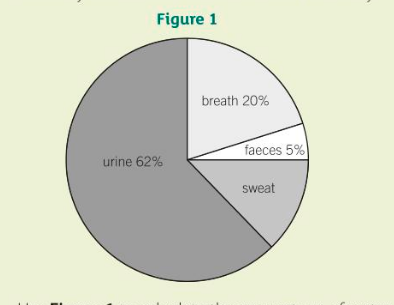
Answer
13 (%)
Answer
for cooling (the body)
or
to maintain body temperature
Answer

less water would be lost in urine
Answer
![]()
protein
02.6 Some people with kidney failure are treated by dialysis. Other people with kidney failure have a kidney transplant.
In dialysis treatment the blood is filtered through a machine.
A kidney transplant is more cost effective than dialysis treatment.
The cost of one kidney transplant operation is £20000. After a kidney transplant the patient has to take drugs to make sure the kidney is not rejected by the body. The drugs cost £5000 per year.
Answer
£70 000
Answer
£230 000
Answer
any one from:
- shortage of kidneys / (kidney) donors
- kidneys do not tissue match
Banner 2
Disclaimer
Disclaimer: I have tried by level best to provide the answers and video explanations to the best of my knowledge. All the answers and notes are written by me and if there is any similarity in the content then it is purely coincidental. But this is not an alternative to the textbook. You should cover the specification or the textbook thoroughly. This is the quick revision to help you cover the gist of everything. In case you spot any errors then do let us know and we will rectify it.
References:
BBC Bitesize
AQA GCSE Science Kerboodle textbook
Wikipedia
Wikimedia Commons
Join Our Free Facebook Group : Get A* in GCSE and A LEVEL Science and Maths by Mahima Laroyia: https://www.facebook.com/groups/expertguidance.co.uk/
For Free Tips, advice and Maths and Science Help
This page contains the detailed and easy notes for AQA GCSE Biology Cell Biology for revision and understanding Cell Biology.
Banner 1
New (9-1) AQA GCSE Biology Paper 2: Complete Revision Summary
HOMEOSTASIS AND RESPONSE
Banner 2
4.5 Homeostasis and Response
- Homeostasis
- Human Nervous System
- The Brain
- The Eye
- Thermoregulation
- Endocrine System
- Control of Blood Glucose
- Osmoregulation
- Human Reproduction
- Contraception
- Negative Feedback
- Plant Hormones
Banner 3
HOMEOSTASIS – The process of maintaining the constant internal environment

Nervous System and the Hormonal System
Homeostasis is important for the enzymes as the enzymes control all the reactions of the body and they need optimum condition to work.
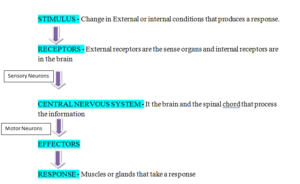
NEURONES
Motor Neurone
- Motor Neurones connect the CNS to the Effectors
- Takes impulses away from CNS
- Motor neurones sends the message from the central nervous system to the effectors.
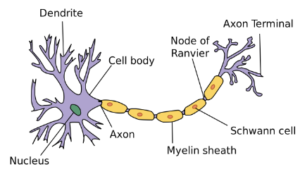
Sensory Neurone
- Sensory Neurones connect sense organs with the Central Nervous System.
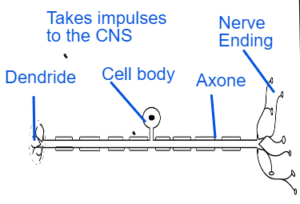
Relay Neurone
- Relay Neurones are present in the CNS and occur between the sensory and motor neurons for distant transmission of Impulses.
- Found in CNS
- Connect Sensory and Motor Neurones
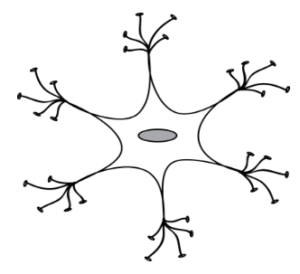
Banner 3
REFLEX ACTIONS
- It is the automatic response of the body to a stimulus.
- In reflex action the message from the sensory neurones is passed to the spinal chord instead of brain.
- Spinal Chord sends the message to the effectors and produce a response
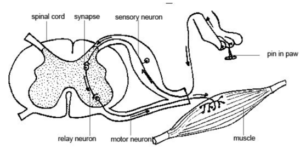
Example: Knee Jerk Reflexes,
- Touching hot object, Sudden closure of light with bright light
- It is rapid
- It is quick Automatic, Instantaneous without conscious thoughts
Stimulus
|
Receptor
| Sensory neurones |
Spinal Chord
Motor neurones
Effector
Response
SYNAPSE
Message is transmitted by chemicals
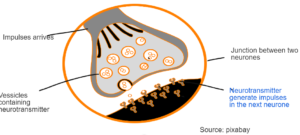
BRAIN – It is the Central information processing organ of our body, and acts as the command and Control System.
CEREBRUM (Cerebral Hemisphere) – It is nearly 80% part of the brain
- Consciousness
- Memory
- Intelligence
- Language
CEREBELLUM – It lies behind the cerebrum and above the medulla oblongata. It is the second largest part of brain and is highly convoluted area which accommodates many neurons.
- Muscle Coordination
- Balance
MEDULLA OBLONGATA or oblong marrow is oblong cylindrical part of the brain. It forms the hindermost part of the brain.
- Unconscious Activities like Heart Rate, Breathing.
- Gut Movement
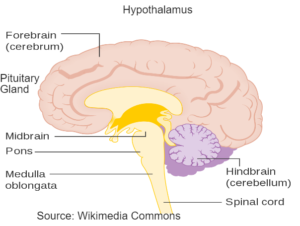
Banner 4
BRAIN SCAN
Magnetic Resonance Imaging (MRI) helps to take the Images of different parts of the brain and relating it with loss of functions of the individual
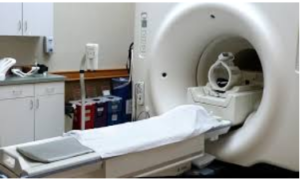
Problems
- Brain is complex
- Skull protects the brain
- Thousands and neurones and neurotransmitter are involved
- The functions of different parts is still not understood.
- Drugs do not reach the brain
Eye – It is lodged in orbit of skull, hollow, spherical organ, about 2.5 cm in diameter and about 6-8gram in weight
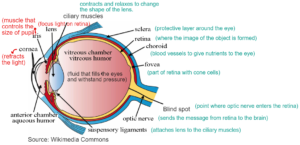
ACCOMMODATION- Ability of eye to adjust the focal length of the lens to make clear image of the objects lying at varying distances. It is a reflex mechanism and is done with the help of ciliary muscles and suspensory ligament.

For distant vision, ciliary muscle relax making the suspensory ligaments tensed which inturn make the lens thin so that the image is focussed on the retina.
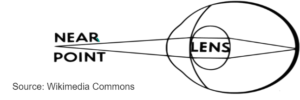
For near vision, ciliary muscle contract making the suspensory ligaments to slack which inturn make the lens thick so that the image is focussed on the retina.
Banner 5
DEFECTS OF VISION
MYOPIA
- Short sightedness
- The image falls in front of the retina of the eye.
- Eye ball gets elongated
- corrected by concave lens
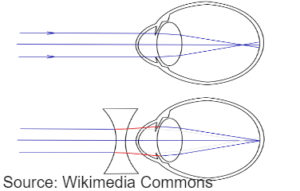
HYPERMETROPIA
- Long sightedness
- The image falls behind the retina of the eye.
- Eye balls gets shortened
- corrected by convex lens
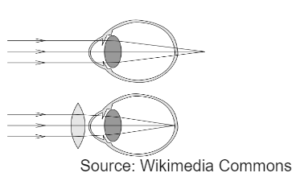
NEW EYE TECHNOLOGIES
Contact Lenses
- Lenses are placed on the surface of the eye.
- Includes soft, silk and disposable lenses
- Can be used by any person at any age
Laser Surgery
- Laser is used to change the thickness or the curve of the cornea so that defects of vision can be corrected.
- Can be done on adults after the growing age.
Replacement Lens
- It involves either replacing the faulty lens or inserting the correct one with the faulty one.
- Include damage risk to the eye.
HORMONAL CONTROL
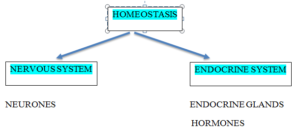
HORMONAL and NERVOUS SYSTEM
Hormones
- They are chemical messenger secreted by the endocrine glands
- they are secreted in the blood and travel to the target organ
- Target organ has receptors and hormones
- bind to the receptor and triggers a response
- It produces a slower but long term response
Nervous System
- Is the system of neurones which send electrical impulses to produce a response
- The message is transmitted via electrical impulses
- The response produced is localised and impulses do not travel large distances
- It produces quick but short term response
Baneer 6
PITUITARY : THE MASTER GLAND – Smallest endocrine gland of the body. It is pea shaped, ovoid, reddish brown gland situated at base of the brain in cavity, sella turcica of sphenoid bone. It controls almost all endocrine glands. Hence it is also called master gland
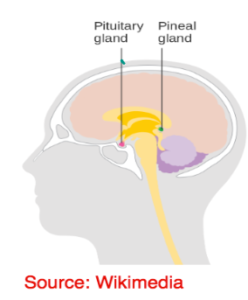
- Master Gland
- It controls other glands of the body
- Follicle Stimulating Hormone
- Antidiuretic Hormone
- Thyroid Stimulating Hormones
EXAMPLES
| GLAND | HORMONE | TARGET ORGAN | EFFECT |
| Pituitary | Follicle stimulating hormone (FSH) Thyroid stimulating hormone (TSH) Anti-diuretic hormone (ADH) | Ovaries Thyroid Gland Kidneys | make the female sex hormones estrogen stimulate the gland to release thyroxine which control metabolism controls the water level by causing reabsorption of water |
| Thyroid Gland | Thyroxine | Liver and Kidneys | Controls the metabolism |
| Adrenal Gland | Adrenaline | Liver and Heart | prepares for fight and flight |
| Testes | Testosterone | Male reproductive organs | Developes secondary sexual characterstics |
| Pancreas- | Insulin Glucagon | Liver Liver | Decreases blood glucose levels Increases blood glucose levels |
| Ovaries | Oestrogen Progesterones | Female reproductive organs | Controls the development of egg, menstural cycle and develop secondary sexual characteristics. |
Banner 7
CONTROL OF BLOOD GLUCOSE
- Pancreas Insulin and Glucagon (lowers the blood glucose level)
- Increases the blood glucose level)
- Insulin Effect
- It increases the permeability of cells to glucose
- It converts excess glucose to -glycogen
- It converts excess glucose to fats
- It stops the breakdown of fats
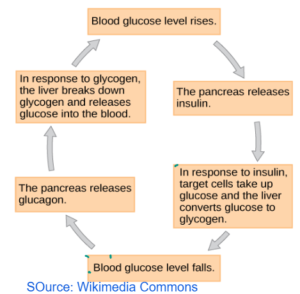
Glucagon ‘is the hormone
Glycogen is the stored carbohydrate
DIABETES
| TYPE 1 | TYPE 2 |
| Insulin dependent | Insuline independent |
| Body does not produce insulin | Body is resistance to insulin |
| Caused by damage to pancreas | Caused by poor lifestyle and diet |
| Treated with insulin injections | Treated with lifestyle changes |
| Most common in young age | Common in obese people |
| It can be genetic. | It is mostly environmental. |
| Drugs might not be required | Drugs are given to make body to respond to insulin |
Banner 8
DIABETES TREATMENT
TYPE 1
- Insulin injections directly into the blood stream.
- Less taken orally as being a protein hormone it can get digested by stomach.
- The insulin converts excess glucose into glycogen and control the blood glucose level.
- Less intake of carbohydrates.
- Pancreatic Transplant
- Pancreatic Cell Transplant
- Using stem cells to regenerate pancreatic cells.
TYPE 2
- Balanced diet
- Regular Exercise
- Weight Management
- Drug to increase sensitivity of pancreas to insulin
- Insulin injections to increase the concentration of insulin to make them more responsive to insulin.
NEGATIVE FEEDBACK
- When the level of anything rises above optimum like glucose concentration, water concentration or temperature negative feedback decreases it
- When the level of anything decreases below optimum the negative feedback raises it.
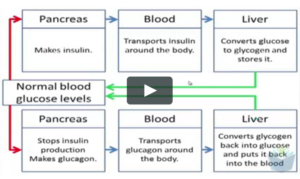
FIGHT OR FLIGHT HORMONE
- Stress Hormone
- Increase heart rate
- Increase breathing rate
- Dilate the pupil

Emergency Hormones
- Increase Blood Flow
- Increase the flow of oxygen to the brain
- Divert blood flow away from the gut
HUMAN REPRODUCTIVE SYSTEM
TESTOSTERONE
Male hormone responsible for secondary sexual characters
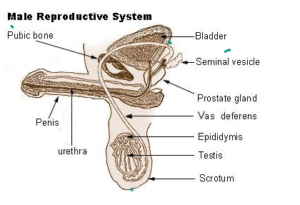
OESTROGEN
Female hormone responsible for secondary sexual characters
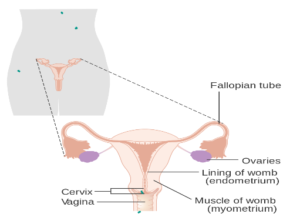
MENSTURATION CYCLE
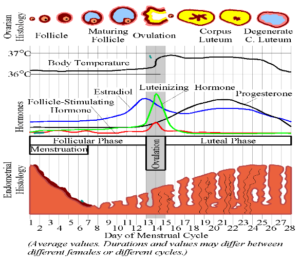
| Days | Phase | Development |
| Day 1- Day 4 | Mensturation | Shedding of the uterus linning along with the egg. Progesterone falls |
| Day 5- Day 14 | Follicular Phase | Egg is matured in the ovary. Increase in FSH |
| Day 14 | Ovulation | Egg is released. Caused by Lutenizing Hormone |
| Day 14-Day 28 | Luteal Phase | Increase in progesterone and oestrogen which maintains the uterus linning and wait for eggs to fertilize. If not fertilize in next 14 days linning breaks. |
HORMONES OF MENSTURATION
| Hormone | Gland | Effective Days | Effect |
| Follicle Stimulating Hormone (FSH) | Pituitary | Day I-Day 14 | Maturation of egg in the follicle. Stimulate the production of Oestrogen |
| Lutenizing Hormone (LH) | Pituitary | Day 14 | Cause Ovulation |
| Oestrogen | Ovaries | Day 14-Day 28 | Develops uterus lining. Stimulates LH and inhibit FSH |
| Progesterone | Empty egg follicle in the ovaries | Day 14- Day 28 | Maintains linning of uterus and prepare for pregnancy. Inhibits both LH and FSH So no mensturatlon happen during pregnancy. |
CONTRACEPTION METHODS
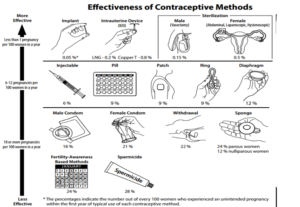
Preventing Sperms to reach the egg. Preventing the implantation of the zygote in the uterus.
Barrier Methods: Prevent the sperm to meet the eggs
Hormonal Methods: Prevents the eggs to mature or prevent the implantation of eggs in the uterus.
Chemical Methods: Kills the sperm
Intrauterine Device: Prevent embryo from implanting
Surgical Method: It is permanent contraception
HOW CONTRACEPTION WORKS?
Contraceptive Pills
- They contain the mix of female hormones oestrogen and progesterone. -MIX PILL
- Prevent the release of FSH preventing the maturation of eggs
- Make thick mucus in the cervix to prevent the entry of sperms.
- Prevent the uterus linning development, preventing implantation.
- Some pills are progesterone only pills.
- A contraceptive implant is also inserted which slowly release progesterone in the uterus.
- A contraceptive patch also absorbs the mix of hormones into the blood
- Side Effects: blood pressure, has to be taken daily changes in menstural pattern
Contraceptive Pills
- They contain the mix of female hormones oestrogen and progesterone. -MIX PILL
- Prevent the release of FSH preventing the maturation of eggs
- Make thick mucus in the cervix to prevent the entry of sperms.
- Prevent the uterus linning development, preventing implantation.
- Some pills are progesterone only pills.
- A contraceptive implant is also inserted which slowly release progesterone in the uterus.
- A contraceptive patch also absorbs the mix of hormones into the blood
- Side Effects: blood pressure, has to be taken daily changes in menstural pattern
Intra Uterine Device
- Copper T is inserted into the uterus
- It releases copper ions which are toxic to sperms
- The device also prevent the implanting of the embryo into the uterus
- Some releases progesterones which works the same like contraceptive pills
- Prevent the release of FSH preventing the maturation of eggs
- Make thick mucus in the cervix to prevent the entry of sperms.
- Prevent the uterus linning development, preventing implantatiom
- Side Effects: Infection; Internal Bleeding
Surgical Methods
VASECTOMY: Male Sterlization
- Sperms ducts are cut and sealed so that the sperms cannot enter the urethra preventing fertilization.
TUBECTOMY: Femal Sterlization
- The oviducts are cut and tied to prevent the release of egg which prevent
- Sterlizatlom
- Side Effects – It is permanent.
INFERTILITY PROBLEMS
OVULATION PROBLEM
- The eggs do not mature or problem ovulating.
- The women is given fertility drugs which are the mix of FSH and LH that stimulated maturation and ovulation
FAULTY TUBES
IMPLANTATION
- In Vitro Fertilization where fertilization is performed in the laboratory and the embryo is implanted back in the uterus for the development
PREGNANCY DEVELOPMENT
- Surrogate Mother where the fertilized egg is implanted into another mother who gives birth
IN VITRO FERTILIZATION
- Expensive
- Results in multiple embryos
- Premature births
- Birth with disability
- Not always successful
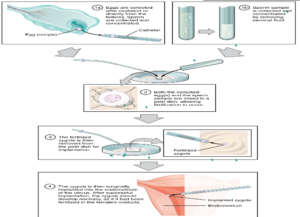
Fertility drugs to stimulate ovulation
Ovary and sperm are collected to perform fertilization.
Fertilized egg is developed in the laboratory giving suitable conditions to develop into an embryo.
Embryo is inserted into the uterus
Develops into a baby.
Plant Hormones
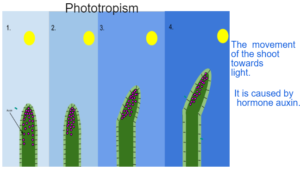
Auxin is produced in the shoot tip. When light falls on auxin it is displaced to the shader side promoting growth of the shader region resulting in growth of shoot towards light.
Gravitropism – The movement of roots towards gravity.
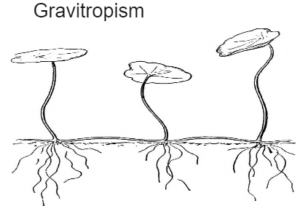
- It is also caused by auxin. In roots auxin inhibits the growth of the roots at the lower side resulting in bending of the root downwards.
- Auxin is displaced to lower side in response to gravity.
PLANT HORMONES
AUXINS
- It stimulates cell divsion and growth of the plant
- It is used to stimulate rooting in tissue culture.
- Used as Weedicide causing excess growth of the weed and killing them.
GIBBERLINS
- Seed germination
- Promote flowering
- End seed dormancy
- Elongation of stem.
ETHENE
- It is a gaseous hormone
- It is involved in fruit ripening
- Allows transportation of raw fruit to long distances and then they can be ripped by ethene.
Cytokinin
Caused Cell Division
Abscicic acid
Stress hormone prepared the plant for stress conditions
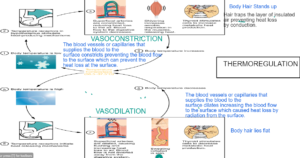
Banner 9
WASTE PRODUCTS
The products produced during metabolic reactions like respiration, digestion etc.
Carbon Dioxide
- Produced during respiration.
- Is excreted out through the lungs by the process of expiration
- Carbon dioxide is harmful as it can alter the pH of the blood affecting enzyme activity.
Water
- Produced during respiration and digestion process.
- Is excreted through skin in the forms of sweating or some by breathing and by kidney in the form of urine.
- Water can also disturb the osmotic balance and salt level of the body.
Urea
- Produced by the liver by metabolising excress proteins as it is toxic and cannot be stored.
- It is excreted by Kidney in the form of Urine.

HUMAN EXCRETORY SYSTEM
ULTRAFILTRATION
- Kidneys filters the blood at a very high pressure.
- All the water, glucose, and useful components gets into the kidney filtrate. The blood cells and blood proteins due to their bigger Size are not filtered.
SELECTIVE REABSORPTION
- Since the kidney contains useful substance in the filtrate it reabsorbs back them into the blood.
- The water also gets reabsorbed depending on the needs of the body.
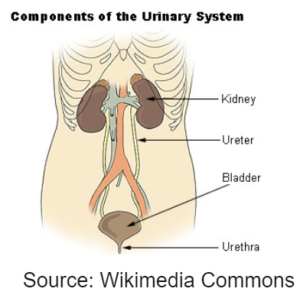
OSMOREGULATION
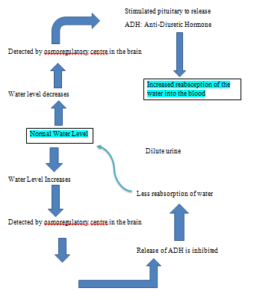
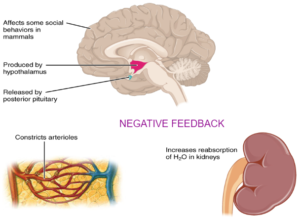
DIALYSIS
- Artificial Kidney blood flows into the dialysis machine which contains dialysis fluid.
- Dialysis fluid contains the same concentration of essential minerals ions,as that of blood but no urea.
- As blood flows into the dialysis fluid, urea is diffused out along the concentration gradient and excess salt is also removed maintaing the normal salt and mineral ions level.
- The clean blood is then pumped back.
- Lifestyle changes, regular visits, change in diet and regular expenditure are some of the disadvantages.
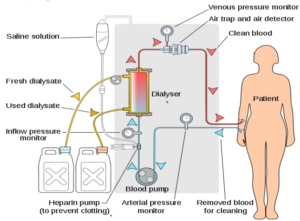
Banner 10
KIDNEY TRANSPLANT
- Replacing diseased kidney with the healthy one.
- The donor should be a close relative to prevent rejection.
- The person has to be on Immuno – suprresant drugs so that the body immune system does not reject it.
- Does not last long and person is prone to other infectious diseases due to immuno suppresant drugs.
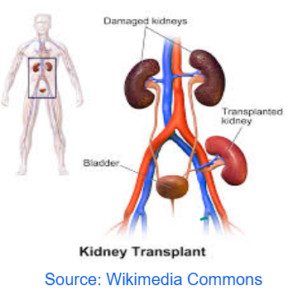
DIALYSIS KIDNEY TRANSPLANT
DIALYSIS
Advantages
- No surgery
- No infection
- No immuno supressant drugs
- Easyily available
Disadvantages
- Lifestyle changes
- Regular visits and long procedure
- Restricted Diet
KIDNEY TRANSPLANT
Advantages
- No regular visit
- No lifestyle changes
- No diet restriction
Disadvantages
- Does not last forever
- Chances of rejection
- Immuno supressant drugs to be taken
- Person is more prone to infections.
- Finding a suitable donor is a problem
Banner 11
KEY TERMS
- Homeostasis – Homeostasis is the process of an organism to maintain a stable internal environment adequate to sustain life.
- Receptors – Receptor is any cell or organ of an animal capable of detecting a stimulus is a change in the external or internal environment and which subsequently brings about a response in the behavior of the animal.
- Effectors – Effector is any muscle, gland or an organ capable of responding to a stimulus, particularly a nervous impulse.
- Stimulus – A biological stimulus is any external change in the environment that can be detected by an organism.
- Neurones – These are structural and functional Units of Neural System. Each Neuron consists of the cell body (cyton) and nerve fibre (axon)
- Central Nervous System – Consists of Brain and Spinal cord
- Sensory Neurones – These connect sense organs with the Central Nervous System.
- Motor Neurones – These connect the CNS to the Effectors
- Relay Neurones – These are present in the CNS and occur between the sensory and motor neurons for distant transmission of Impulses.
- Reflex Arc – The path followed by the stimulus (impulse) from beginning to end is the reflected arc.
- Brain – It is the Central information processing organ of our body, and acts as the command and Control System.
- Cerebral Cortex – Grey matter forms 2-4mm thick outer cortex of cerebrum called cerebral cortex
- Cerebellum – literally means little cerebrum. Cerebellum has grey matter on outer side and made of three layers of cells and fibres. 2nd largest part of the brain.
- Medulla – directly controls some ANS responses, such as heart rate, respiration, dilation of blood vessels, digestion, sneezing, swallowing and vomiting. It is a part of the brain stem, located just below the prominence and just above the spinal cord.
- Magnetic Resonance Imaging (MRI) – It helps to take the Images of different parts of the brain and relating it with loss of functions of the individual
- Eye – Hollow spherical organ, about 2.5cm in diameter and about 6-8gm in weight. It is lodged in orbit of skull.
- Blind Spot – The spot on the retina which has no receptor.
- Accomodation- Ability of eye to adjust the focal length of the lens to make clear image of the objects lying at varying distances. It is a reflex mechanism and is done with the help of ciliary muscles and suspensory ligament.
- Ciliary Muscles – help in accommodation and ciliary process that secrets aqueous humour.
- Iris – Visible coloured portion of the eye, contains two types of muscles- circular and radial.
- Pupil – In front of the lens the aperture surrounded by the iris is called the pupil.
- Myopia – Also known as near sightness or short sightness. Near object is Clear. Far object is not clear. Eyeball become longer.
- Hypermetropia – long sightness. Far object is clear, near object is not Clear. Eyeball becomes short.
- Endocrine System – the endocrine system consists of glands widely separated from each other with no direct anatomical links. Also called ductless glands
- Hormones – Hormones are the chemical substances produced in the body that controls and regulates the activity of some cells or organs.
- Adrenaline – It is a hormone released by the adrenal glands and its main action, along with norepinephrine, is to prepare the body to “fight or flee”.
- Insulin – Secreted by Pancreas, is a small protein whose molecule consists of two polypeptide chains
- Pituitary Gland – Smallest endocrine gland of the body. It is Pea shaped, ovoid, reddish brown gland situated at base of the brain. It controls almost all endocrine glands. Hence it is also called master gland.
- FSH – Follicle Stimulating Hormone. In males stimulates spermatogenesis. In females growth of ovarian follicles upto ovulation.
- Oestrogen – stimulation of growth and activities of female secondary sex organs, development of growing ovarian follicles, mammary gland development.
- Progesterone – it acts on the mammary glands and stimulates the formation of alveoli, milk secretion and supports pregnancy.
- Glucagon – Glucagon is produced to maintain blood glucose levels during fasting and to increase very low glucose levels.
- Glycogen – Glycogen is the major carbohydrate storage form in animals, and corresponds to starch in plants.
- Diabetes – Diabetes is a disease in which your blood glucose, or blood sugar, levels are too high.
- Mensturation – Menstruation or your period is the shedding of the uterine lining once a month.
- Ovulation – the release of an egg from an ovary — occurs about midway through the menstrual cycle.
- Phototropism – It is the ability of a plant, or other photosynthesizing organism, to grow directionally in response to a light source.
- Gravitotropism – Gravitropism is a plant’s natural growth response to the effects of gravity.
- Auxins – Auxin is involved in cell growth and cell expansion
- Gibberlins – Gibberellins promote stem elongation between nodes on the stem.
- Dialysis – The process of removing waste products and excess fluid from the body.
- Selective Reabsorption – Selective reabsorption is the process by which some molecules (eg – Ions, glucose and amino acids), after having been filtered by capillaries together with nitrogen waste products (eg Urea) and water in the glomerulus, are reabsorbed by filtration as they pass through the nephron.
Make sure you have watched the above videos and are familiar with the key definitions before trying these questions. It is also good to time yourself while doing these questions so that you can work on the speed as well.
